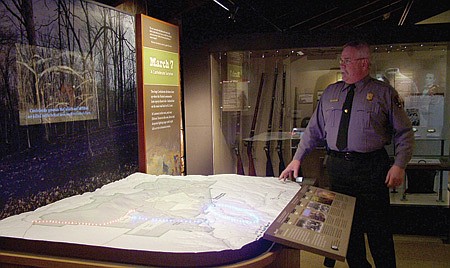New technology tells an old story
BATTLE OF PEA RIDGE IN LIGHTS - Blue and red lights show troop movements on the new interactive display at Pea Ridge National Military Park as a video plays depicting battle scenes. John Scott, superintendent, said the new displays are designed to educate visitors about the events of the Battle of Pea Ridge which occurred March 7-8, 1862.
Wednesday, March 3, 2010
PEA RIDGE — Scenes of the grueling two-day Battle of Pea Ridge are reenacted and narrated in a video while blue and red lights appear to move along an interactive map showing visitors where the Union and Confederate armies trod in the chilling days of March 7-8, 1862.
The 4,300 acres now owned by the federal government was privately-owned land, the site of many farms.
A replica gun, artillery shell and soldier’s knapsack are included in displays that can be touched. One can see just what happens when a tree is stuck by a cannon ball or when nearby cliffs are blown into deadly shrapnel.
The museum preserves scenes and facts from the battle, but also the commonly overlooked aspect of civilian life before troops marched on the land.
“This battle happened on people’s farms, people’s houses,” John Scott, park superintendent, said.
The new exhibits are designed to help visitors understand what it may have been like to look out a window to see soldiers marching across the field where livestock roamed and into the fenced area where crops grew and into a home where a family lived.
This renovation has been years in the making.
Scott said designers received input from local, regional and national historians, plus members of the Cherokee Nation and Harpers Ferry Center to put together ideas for the new exhibits to help visitors understand the beginnings, the brutal days and the outcome of the battle.
The museum doesn’t have many actual artifacts from the battle, that is things the soldierswould have worn or carried with them. Scott attributed this to the timing of the battle, soldiers moving out of the area and the lawlessness that ransacked the land when the fighting was over.
However, the mannequins in the museum are life-like body types and display clothing and military items of the 1800s.
Soon to be added is a coverlet owned by Mr. Putman to be featured near a display showing a family fleeing from their home with what they can carry.
History, facts and reasons for the war and common misunderstandings are displayed throughout the museum, along with quotes from prominent military figures throughout history.
The coat worn by General Samuel Curtis is encased in glass with just enough light so not to damage it. The display leads into leadership roles important in the battle.
Scott said a lot of people don’t realize this information is used today in modern military studies.
Junior officers from Fort Leonard Wood in Missouri and Fort Sill in Oklahoma come to the park to study the mistakes made during the war.
“All the time we just looked at (the plans) on paper. Now to see it in three dimensions really exceeds our expectations,” Scott said.
The battlefield is close to being restored without modern intrusions. It is quickly becoming a destination civil war park, bringing visitors to the area and strengthening the local economy.
The museum will reopen to the public at 8 a.m. Wednesday, March 3. The anniversary of the battle will be commemorated from 8 a.m. to 5 p.m. Saturday, March 6.
A dedication is expected the first part of May.
News, Pages 1 on 03/03/2010
